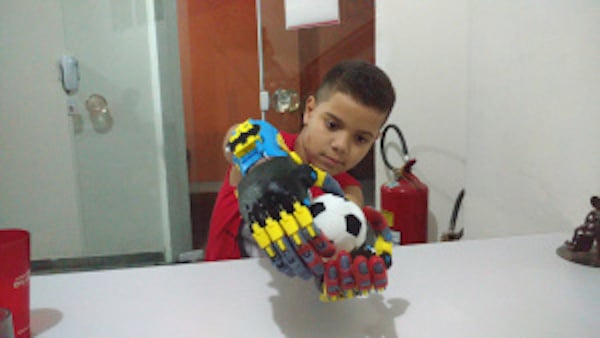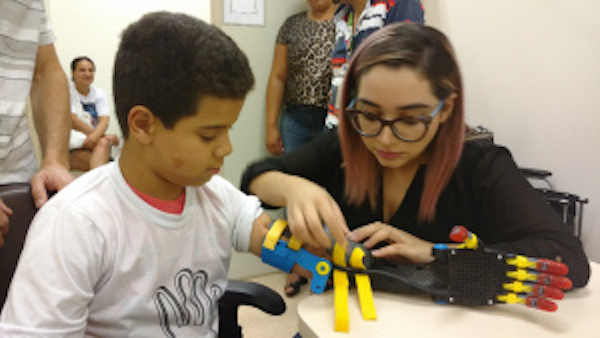
Maria Elizete Kunkel is a Professor of Biomedical Engineering (Biomechanics) at the Federal University of Sao Paulo (UNIFESP), Brazil.
She also coordinates research projects in Assistive Technology fields at the Federal University of Sao Paulo UNIFESP and the Federal University of ABC UFABC. She studied Physics, Science Journalism and Biomechanics in both Brazil and Germany. She is building Mao3D, a platform dedicated to 3D Printing prosthetics for Brazilians.
Nora Toure: Maria, could you let us know about your background and what brought you into 3D Printing in the first place?
Maria Elizete Kunkel: My parents were born in a small village that went through great periods of drought in northeastern Brazil and never went to school. After their wedding, they moved to a larger city. I am the second of their 4 children. Thanks to them and their work, I had a good school education: I have a degree in Physics, specialization in Scientific Journalism and MSc in Biomechanics, all these courses were taken in Brazil. In 2012, I received my Ph.D. from Ulm University in Germany on computational modeling of the human spine. After 8 years in Germany, I returned to Brazil in 2012 to work as a guest professor for biomechanics at the Federal University of ABC (Sao Paulo) in the Biomedical Engineering field.
In 2013 my interest in 3D printed prosthetics was awakened after I saw a video of a carpenter from southern Africa named Richard van As. In the video, Richard reported that in 2011 he lost part of his hand in a work accident. He explained how thanks to an American designer, he produced a functional model using 3D printing. Richard reported also the creation of an NGO (non-governmental organization) called Robohand to donate this type of hand prosthesis to children in South Africa. In the prototype of prosthesis described by Richard, I saw a thousand of possibilities in biomechanics. The prosthesis was simple, functional and low cost, these are characteristics required for prosthesis development in countries such as Brazil.
Nora Toure: Could you detail your very first experience with 3D Printing?
Maria Elizete Kunkel: I was trained to use a Stratasys 3D printer from UFABC. My first attempt was to print a hand prosthesis using the NGO Robohand open source files available on the internet. With the help of students, I simulated an amputation by bandaging my fingers. We 3D printed a scaled model fitting my hand. We then fixed everything with screws, wires, and elastics. I tested the prosthetics at home, using it to manipulate some objects. It was then, after seeing that these tests were successful, that I decided to dive headfirst into the world of 3D-printed hand prosthetics, a field that has the potential to help millions of people but that is still fairly new in Brazil.
Soon after that, I learned from Richard about the creation of an American NGO, E-nable that had several models of upper limb prostheses that would also be available on the internet. Using the experience of Robohand and E-nable, we developed a pilot project with a hospital of orthopedics and traumatology of the University of Sao Paulo. This was the first 3D prosthesis for an adult who had lost both hands recently in an occupational accident in Brazil.
Nora Toure: What are the applications you’re looking to resolve using 3D Printing in terms of Assistive Technology?
Maria Elizete Kunkel: My research group is looking for solutions to current Brazilian problems in the areas of prostheses and orthoses. Most of these devices are currently imported by Brazil, which implies delays and very high costs. The Brazilian public health system has a great deal of difficulty in meeting the needs of people who need prostheses. In this way, the development of customized and low-cost prostheses and orthoses may offer an alternative to meet this need and demand.

We are developing models of upper, lower and hip limbs produced by 3D printing technology. The use of 3D printing brings numerous advantages such as lighter and durable devices, color-coded, more comfortable, etc. In addition to orthoses, we are doing research on upper limb prosthesis more suitable for children, we use open-design models from the American NGO E-nable that we adapt to improve the biomechanics.
We have a project where a methodology is being developed for the production of an aesthetic prosthesis of ears based on medical images of the patient and 3d printing. In addition to these ongoing projects, we are initiating meetings with medical surgeons from the Sao Paulo hospital of various specialties to develop projects with internal devices such as orthoses for trachea, ribs, vertebrae and plates for surgeries in cases of hand fractures, in this case we need to use new types of material flexible and titanium.
Nora Toure: What challenges do you face in using 3D Printing to build prosthetics?
Maria Elizete Kunkel: I created a University Extension Program named Mao3D to attend to the high demand for prosthetics that exist in Brazil. Standard prosthetics are both costly and difficult to produce around here; so much, in fact, that we have over 18,000 unattended children amputees only in the city of São Paulo! I saw the need to create a new field of research, one that would greatly contribute to our society. Our first roadblock in making this technology accessible was the price of the 3D printers themselves. Since 2014, we have national production of 3D printers and filaments in Brazil. This has reduced the cost of this technology and increased the chances of using this technology.
Nora Toure: Do you face specific challenges as a female searcher?
Maria Elizete Kunkel: Yes, throughout my university education, both in Brazil and in Germany, where I did my PhD, there were challenging situations. For a woman to finish a university course and to lead a research group she goes through many difficulties due to the prejudices still existing in the current society, this still happens all over the world. In Brazil, the area of 3D printing is still a predominantly male area, I say this because I have participated in most of the events are academic or business and I am usually the only female speaker. In my research group, we have more women than men and I have participated in events that seek to demystify this as well.
Nora Toure: What was the most impressive or impactful use of 3D printing you’ve seen so far?
Maria Elizete Kunkel: I am very interested in 3D printing because this type of technology allows to create what does not yet exist yet and this is very challenging in the area of health, for example, we have many problems where a simple solution can be developed and the health professionals themselves can participate in this process.

Nora Toure: In your opinion, how could we encourage more women to become involved with 3D printing?
Maria Elizete Kunkel: I use 3D printing concepts in all my activities whether it’s during classes, in social projects or research. I see the women interested in the subject but they are discouraged when they need to learn how to use programs and deal with the mechanics of 3D Printing. The problem is prior to our present time and comes from the low number of women in engineering courses. In my research group, girls are more engaged than boys. The girls are the one doing all the part of 3D modeling and printing in order to find solutions for the problems arising from the process. We are also planning for 2017 the creation of 3D modeling workshops for girls.
Thank you for reading and for sharing! You can contact Maria by email at [email protected] and follow Mao3D’s actions on their Facebook page.
We invite you to join Women in 3D Printing on LinkedIn and Facebook for further discussion.

